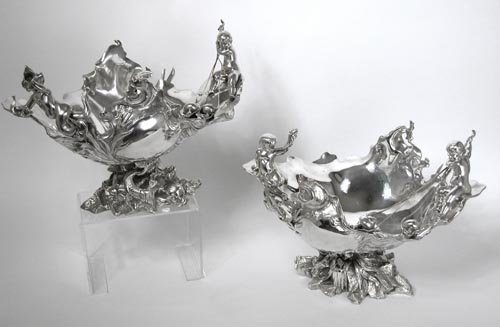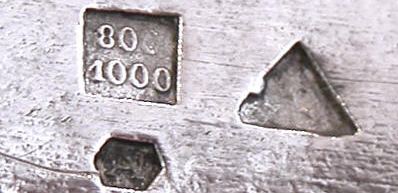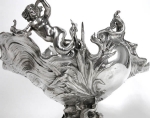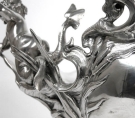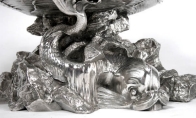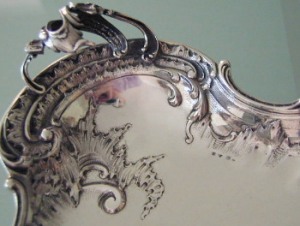by Martine
D’Haeseleer
(click on photos to enlarge images)
Silverware from the Belgian Workshop
Wolfers Frères
in the Belle Epoque Period
American collectors and specialists in silver usually know
much about French, English, Austrian and German silver, but are
relatively less informed about Belgian silver. This article
about the highly skilled, abundantly ornamented late 19th
century silver from the workshop of the Belgian silversmith
Wolfers aims at closing that gap. It is largely based on my
lectures to younger generations of art lovers over a period of
ten years, through which I have endeavored to open the door to
the discovery of the quality, personality and creativity of
Belgian Silver, particularly that which was made during the
so-called Belle Epoque.
Belgian Belle Époque Silverware
Wolfers Frères’: Jewelers and Silversmiths
Strategically situated on fertile soil at the crossroads of
Western Europe, Belgium has enjoyed economic prosperity,
artistic creativity and a strong tradition of skilled
craftsmanship. It is a small country enriched by the
interweaving of different ethnicities and cultures--a true
melting pot of populations. Surrounded for centuries by France,
Germany, the Netherlands and the North Sea, this “slice” of land
was highly coveted by its neighbors and it was not until 1831
that it achieved true political independence. Since then,
successful industrial development has brought prosperity to an
expanding middle class that was already much in evidence during
the Belle Époque. The words of the Belgian singer, Jacques Brel
“C’était au temps où Bruxelles Brussel ait… “, imply that people
of the Brussels middle class were wealthy, prosperous and
enjoyed life at that time.
Wolfers was one of the most famous Belgian silversmith companies
of the 19th century, its reputation comparable to those of Emile
Puiforcat, Odiot or Aucoc in Paris, Garrard in London, and
Tiffany or Gorham in America.
In the first half of the 19th century, three young German
brothers, silversmiths Edouard, Guillaume and Louis Wolfers
established two workshops in Brussels.
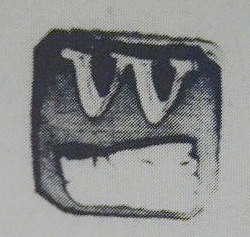 |
In 1852, Louis Wolfers (1820-1892) registered his
maker's mark, consisting of a letter W above a boar's
head. His workshop was situated at 23 rue des Longs
Chariots.
In 1858, he married Henriette Ruthenburg who contributed
to the development of the firm. They took part in many
different exhibitions and competitions and, by 1868, the
firm was achieving financial success.
After serving apprenticeships, their three sons,
Philippe, Max and Robert were sent to France, Germany,
the Netherlands and Austria to prospect for business.
As a result, the Wolfers firm became associated with
Bonnebacker of Amsterdam, P. Kirscher in Düsseldorf,
Goldschmidt in Köln, and Friedlander in Berlin. This
explains why some German assay and retailers marks are
punched with Wolfers marks.
|
|
Louis Wolfers maker’s marks (1852-1892)
|
In 1885, Philippe Wolfers married Sophie Wildstädter. His
bride’s dowry enabled him to become a partner in his father’s
business. The firm was renamed ‘Louis Wolfers Père et Fils’. By
1890, Max was playing an active role in the business. The
workshop and shop moved to the Rue de Loxum.1 and the new shop's
mark: "Louis Wolfers Père et Fils’ Rue Du Loxum 1 Bruxelles" was
conjoined with the former maker’s mark. In 1892, after Louis
Wolfers death, the firm was renamed ‘Wolfers Frères’.
In 1892, the new maker’s mark, three pentacles
(5-point stars) contained in a triangle, was introduced
and continued to be used until 1942. It is a rare
example of a personal mark using Masonic symbols.
|
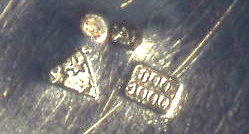 |
| |
Wolfers Frères’ Workshop and maker's marks
(1892-1942)
|
In 1897, Robert Wolfers persuaded the firm to
install hydraulic presses for the production of flatware.
Philippe, the artistic director, played a very important
role in the development of the Art Nouveau in Belgium.
Various jewelers were exclusive agents for Wolfers
products.
For example, E. Antony in Antwerp, E. Bourdon in Ghent,
F.Hardy in Liege, Galerie Aublanc in Paris, and Begeer
in Utrecht.
Branches were opened in Budapest and Bucharest.
Wolfers silver was also imported into Russia.
|
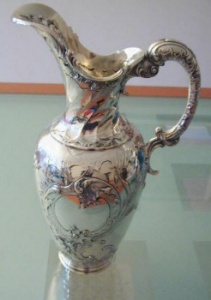 |
| |
Waterjug, maker Wolfer frères, ca.1892-1900
|
In 1907, the Wolfers firm employed about 150 workers. They
moved the shop and workshop to the rue d’Aremberg where the
famous art nouveau architect, Victor Horta, designed a new
building for them. This beautiful building still stands on the
left of a KBC Bank branch and one can admire the shop’s
furniture at the Musée du Cinquantenaire in Brussels
 |
|
Wolfers' shop, rue d’Arenberg 11-13 Brussels,
1911 Architect, Victor Horta.
|
Decorative Arts Styles
An older generation of collectors
considers only 16th, 17th and 18th century silver as genuinely ‘antique’;
19th century silver is considered decadent because of industrial
production that overtook centuries of handmade silver and also
because the emerging 19th century middle social class (i.e., the
‘bourgeoisie’) favored reproductions of 18th century styles (e.g.,
neo-Louis XV or neo-Louis XVI styles)--they wanted to copy the
good taste, manners and ways of thinking of the former
aristocracy and, perhaps more importantly, because they wanted
their silver to reflect their own success and prosperity. The
neo-Louis XV style is often called ‘Rococo’ in a rather
disparaging way, but the term was already in use referring to
18th century Rocaille, an extremely eccentric interpretation of
the Louis XV style.
The so-called Eclecticism of the 19th century is unquestionably
a combination of Louis XIV or Louis XVI patterns with Louis XV
and Rocaille. Yet, if instead of name-calling, we analyze the
styles throughout the different centuries we observe that
evolution of styles does not stop or start abruptly but instead
glides smoothly from earlier forms toward the introduction of
new decorative elements. In the 16th, 17th and 18th centuries,
symmetric, geometric, asymmetric, and floral styles alternately
followed one another.
The Louis XIV style, for instance, was (in a way) a
neo-classical style, influenced by Renaissance architecture and
ornamentation. Similarly, we find 18th century LouisXV and
Rocaille styles reproducing naturalistic motifs of 17th century
Mannerism and spirally fluted Louis XV forms mixed with
‘in-fashion’ Louis XVI motifs.
The quality of 18th century handicraft
is often idealized and the creations of 19th century
silversmiths underestimated. J.F. Hayward in Virtuoso Goldsmiths
said, 'Considering the working methods, we have to put aside
romantic conceptions of the nobility of handwork. The goldsmith
took as much interest in methods of increasing efficiency and
reducing costs of production as any modern factory manager.
Different processes like casting, turning on a lathe or
producing ornaments by means of a stamp were all in use by the
second half of the 16th century'.
Indeed, why should we be so formalist, critical and negative
about the 19th century neo styles? Typical rococo revival was in
fashion in many different European countries, mainly Belgium,
Germany, Austria and even in the Netherlands. The neo-Louis XV
style with its spirally fluted lines was adorned with Rocaille
motifs that were exuberant with crested motifs looking like the
fringe of falling water, or the crest of sea wave and
asymmetrical Rocaille cartouches. Flowers, daisies and reed
flowers were added and rendered even more flourish to the
ornamentation . These crested patterns find their origin in the
influence of Japonisme
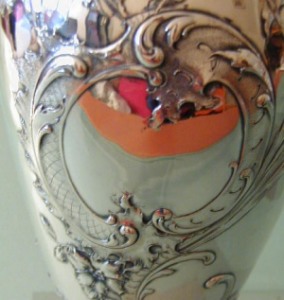 |
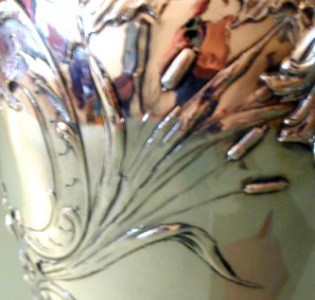 |
|
Detail of Rocaille motif Waterjug
maker: Wolfer frères, ca. 1892-1900
|
Detail, Reed Motif Waterjug
maker: Wolfer Frères, ca. 1892-1900.
|
The wave, as a pictorial theme and
ornamental pattern in Japanese art, had a profound impact on
European painting, graphic art and applied arts in the second
half of the nineteenth century. The crest of the wave motif
belongs to this form.
Philippe Wolfers became familiar with Japanese art through the
opening of ‘La Maison Japonaise’ in Brussels (1866) and the
Vienna world exhibition in 1873. His silver was mostly heavy,
cast or hammered; the decoration chased and engraved. Wolfers’
workshops employed highly skilled workers; there was no room for
low quality stamped production
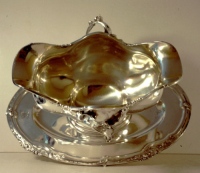 |
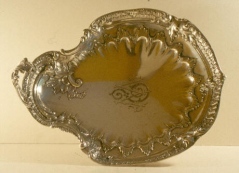 |
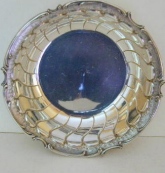 |
|
Sauceboat: maker, Wolfers Frères, ca.
1892-1900.
|
Ice serving dish: maker, Wolfers frères, ca.
1892-1900.
|
Strawberry dish: maker, Wolfers frères, ca.
1892-1900
|
Influence of Japonisme
In order to be credible in stating
that the influence of Japonisme is found in the ornamental
motifs of Wolfers Frères’ silverware at the end of the 19th
century, I have taken a few quotes from the the text of the book
‘Japonisme: The Japanese influence on Western art since 1858’ by
Siegfried Wichmann.
The wave as a pictorial theme and ornamental pattern in Japanese
art had a profound impact on European painting, graphic art, and
applied arts in the second half of the nineteenth century. The
highly stylized wave formula, underwent an intensification of
decorative force in Europe, especially in the Art Nouveau
movement ...
The motifs of the crest of the wave and of individual swirling
eddies both belong to this form and both lend themselves to
quasi-geometrical treatment...
The wave as the subject of a painting is perhaps best known in
Katsushika Hokusai’s 'The Great wave off Kanagawa,'
woodcut (1823-32), Totoya Hokkei, ‘Mekari Festival,'
color woodcut (1830), Maruyama Okyo, 'Screen with Dragon and
wave Pattern' (1780) and 'Japan ‘Stormy sea’ (detail)
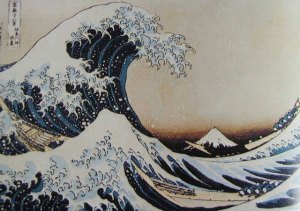 |
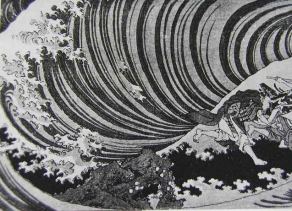 |
|
Katsushika Hokusai: The Great wave off
Kanagawa
Woodcut (1823-32)
|
Totoya Hokkei: Mekari Festival
Colour Woodcut (1830)
|
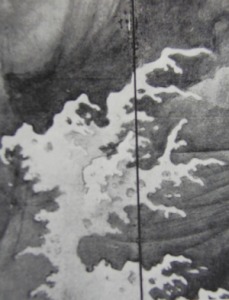 |
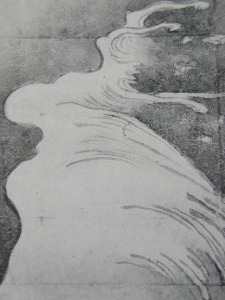 |
|
Maruyama Okyo: Screen with Dragon
and Wave Pattern (1780)
|
Maruyama Okyo: Japan ‘Stormy sea’
(detail)
|
European Painters and graphic artists
(and industrial artists too) produced many variations on the
wave theme around the turn of the century….
Van Gogh introduced this almost calligraphic wave shape into
painting in quite a different
manner, yet still in an impasto’ technique... (in) 'The Sea at
Saintes-Maries- June1888…' .
Georges Lacombe(1868-1916) also gives a detail of a breaking
wave which is clearly influenced by Japan. …. Here is a detail
of a wave seen both realistically and yet a the same time
decoratively
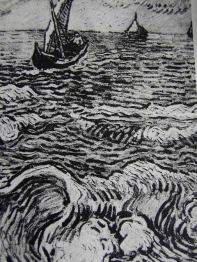 |
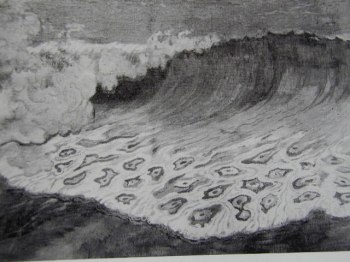 |
|
Vincent Van Gogh
The Sea at Saintes-Maries (June1888)
|
Georges Lacombe
detail
|
I will now draw a few parallels with
photographs of ornamental details from Wolfers' silver
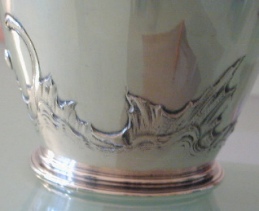 |
 |
|
Water jug-detail
|
Katsushika Hokusai: The Great wave off
Kanagawa
|
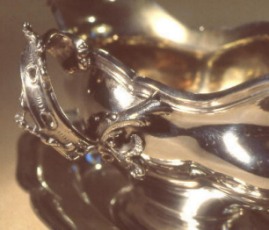 |
 |
|
Handle of the sauce boat
|
Georges Lacombe: detail
|
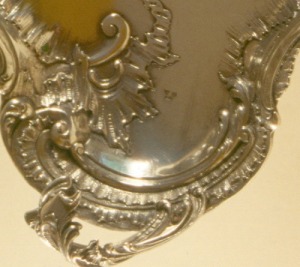 |
 |
|
Details of Ice cream dish
|
Maruyama Okyo: Screen with Dragon and Wave
Pattern (1780)
|
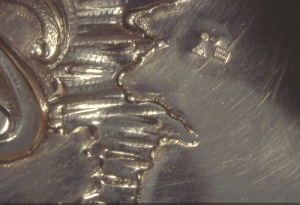 |
 |
|
Details of Ice cream dish
|
Maruyama Okyo:Japan 'Stormy sea' (detail)
|
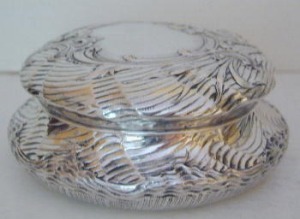 |
 |
|
Bonbonnière
|
Vincent Van Gogh: The Sea at Saintes-Maries
(June1888)
|
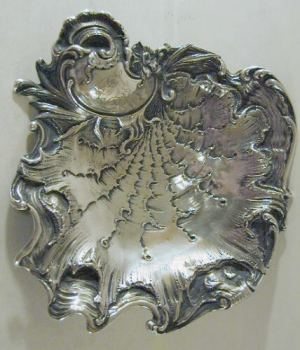 |


|
|
Shell-dish
|
Totoya Hokkei and Maruyama Okyo
|
Belgian Silver Marks
I conclude with a few notes on Belgian
silver marks for those who have been persuaded to take a further
'in vivo' look at Wolfers’ magnificent creations. To defend
against severe competition of imported silver from France and
Germany, the Belgian silversmiths petitioned for a change in the
laws governing their work. As a result, 1868 to 1942 became a
period of great liberalism: official silver standards were
lowered to 900 and 800, no Hallmarking office assay was needed
and, there was no registration of personal marks. As an
unintended consequence of this liberalism, it is today difficult
to identify Belgian silver from that period because each of the
silversmiths and retailers used their personal assay marks.
A silver object is guaranteed by means of two marks: the silver
standard and the maker-manufacturer or retailer’s mark. In
Belgium, the former included the gothic letter 'A' for Argent (silver)
and either a number 1 or 2 for the silver standards, 900 or 800,
respectively (from Tardy, Poinçons d’argent’).
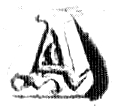 |
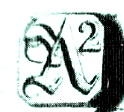 |
|
Belgian official assay marks for silver:
1st standard period (1868-1942)
|
Belgian official assay marks for silver:
2nd standard period (1868-1942)
|
Manufacturers and shops also created
and used a wide variety of other content indications, such as
from 800 to 950 punched alone or combined with the letter A or
combined with a symbol representing the standard in thousandths
(i.e.:Millièmes) (M; Mes; MIL; 1000). As stated above, one often
finds German assay marks (such as the moon crest or the imperial
crown) as well as German retailer’s marks combined with Wolfers’
Belgian marks.
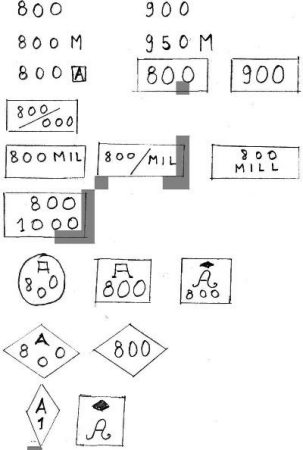 |
|
Belgian silver standards mark for large
items (1868-1942)
(Personal research work)
|
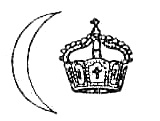 |
The Imperial Crown and the Moon Crescent German
State marks in use since 1888
|
Bibliography
Orfèvrerie au Poinçon de Bruxelles’,
1979, Exhibitions Catalogue Societé Générale de Banque - 13/09
au 30/11 1979.
‘Modern Silver 1880-1940’, Amsterdam 1989, A.
Krekels-Aalbeerse.
‘Silver of a New Era, International Highlights of Precious
Metalware from 1880 to 1940’ Museum Boymans Van Beuningen,
Rotterdam. Museum voor Sierkunst, Ghent 1992.
‘Philippe und Marcel Wolfers’, Art Nouveau und Art Déco
aus Brüssel, 1993-1994, Museum Bellerive Zürich.
‘Van Belle Epoque tot Art Nouveau’, Antwerp 1998, Wim
Nijs, Sterckshof Studies 10
-Belgian Silver 1868-1914. Provinciaal Museum
Sterckshof-Zilvercentrum. Antwerpen-Deurne ISBN 90-6625-007-0.
‘Royal Silver for People and King’, Antwerp 2001, Wim
Nijs, Sterckshof Studies 17.
Provinciaal Museum Sterckshof-Zilvercentrum Antwerpen-Deurne
ISBN 90-6625-028-3
‘Silver’ 1880- 1940 Art Nouveau-Art Déco', Amsterdam
2001, Annelies-Krekel-Aalberse, Arnoldsche
ISBN 3-89790-161-7
‘Les Wolfers Orfèvres, Bijoutiers & Joaillers’, Walter
van Dievoet, Brussels 2002, Edition STUDIA BRUXELLAE
‘Japonisme’ The Japanese influence on Western art since 1858'
Siegfried Wichmann – Thames and Hudson- New York-NY
Photo Credits
All pictures are ©Martine D’Haeseleer
- Many were digitalized by: Studio Durieux - Belgium
Exceptions:
Wolfer hallmarks 1852-1892 and Brussels' shop: ©Catalogue ‘Van
Belle Époque tot Art Nouveau’ Sterckshof Museum’ Deurne
Antwerpen.
Wolfers' centerpiece Aux Maraudeurs--‘Puti playing with snails’:
Courtesy of the Antique Dealers ‘Pash and Son’ – London
Images illustrating 'Influence of Japonisme': © Book :
’Japonisme’ The Japanese Influence on Western art Since 1858-
Siegfried Wichmann – Ed. Thames and Hudson
Martine D'Haeseleer
www.silverbel.com
Text edited With the great and kind help of Ricardo and
Janet Zapata, New York Silver Society
This article was originally Edited with efficient and
friendly help of Marberth Schon
'Modern silver Magazine' March - May 2006 -
www.modernsilver.com
|
|
 ASSOCIATION OF SMALL COLLECTORS OF ANTIQUE SILVER
ASSOCIATION OF SMALL COLLECTORS OF ANTIQUE SILVER















